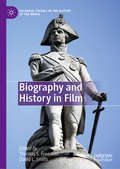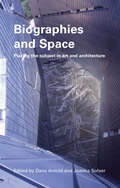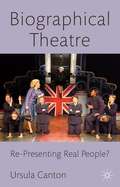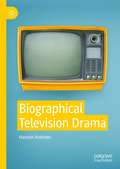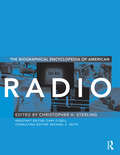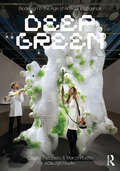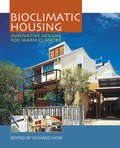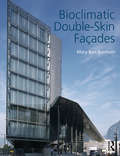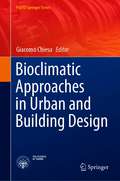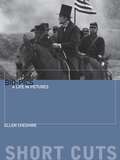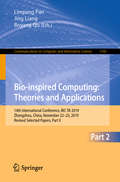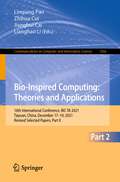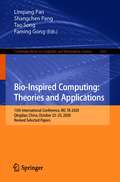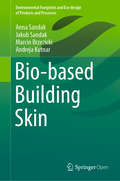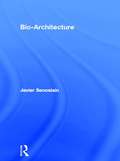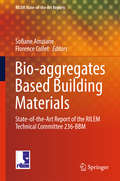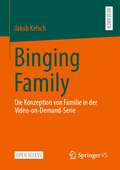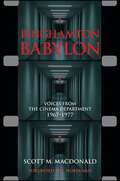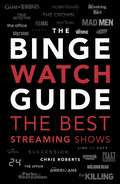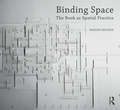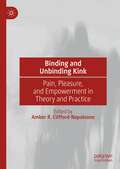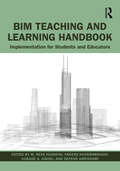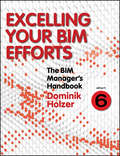- Table View
- List View
Biography and History in Film (Palgrave Studies in the History of the Media)
by Thomas S. Freeman David L. SmithThe essays in this volume seek to analyze biographical films as representations of historical individuals and the times in which they lived. To do this, contributors examine the context in which certain biographical films were made, including the state of knowledge about their subjects at that moment, and what these films reveal about the values and purposes of those who created them. This is an original approach to biographical (as opposed to historical) films and one that has so far played little part in the growing literature on historical films. The films discussed here date from the 1920s to the 2010s, and deal with males and females in periods ranging from the Middle Ages to the end of the twentieth century. In the process, the book discusses how biographical films reflect changing attitudes towards issues such as race, gender and sexuality, and examines the influence of these films on popular perceptions of the past. The introduction analyses the nature of biographical films as a genre: it compares and contrasts the nature of biography on film with written biographies, and considers their relationship with the discipline of history. As the first collection of essays on this popular but understudied genre, this book will be of interest to historians as well as those in film and cultural studies.
Biographies & Space: Placing the Subject in Art and Architecture
by Dana Arnold Joanna Sofaer DerevenskiBringing together a collection of high-profile authors, Biographies and Space presents essays exploring the relationship between biography and space and how specific subjects are used as a means of explaining sets of social, cultural and spatial relationships. Biographical methods of historical investigation can bring out the authentic voice of subjects, revealing personal meanings and strategies in space as well as providing a means to analyze relations between the personal and the social. Writing about both actual (architectural) and imagined (pictorial) space, the authors consider issues of gender, childhood, sexuality and race, highlighting an increasing fluidity and interaction between theory, methods and history. Biographies and Space is an original and exciting new book, with direct relevance to both architectural and art history.
Biographical Theatre
by Ursula CantonMarilyn Monroe, Vincent van Gogh or the victims of rendition flights - the number and variety of historical and contemporary figures represented on British stages is amazing. This book develops a new theoretical framework for the representation of real life figures on stage and examines different ways in which they can be included in performances.
Biographical Television Drama
by Hannah Andrews“Biographical Television Drama breaks new ground as, to my knowledge, the first book-length exploration of the terms in which television engages in biographical storytelling. Backed by robust research in biography studies and British television history, Hannah Andrews deftly unravels the complexities behind the accessibility of biographical television drama. Her book tackles key questions head-on, notably rhetorics and style, narrative and performance and, innovatively, ethics, while also shedding light on the interconnections with other biographical screen forms through a rich corpus. This is an essential critical study that vindicates television drama’s unique place in the histories and practices of screen biography.”-Belén Vidal, Senior Lecturer in Film Studies at King’s College London and co-editor of The Biopic in Contemporary Film CultureThis book explores what happens when biography and television meet, in a novel fusion of the two fields of study. Andrews compares core concepts in biography and television studies such as intimacy, the presentation of the self and the uneasy relationship between fact and fiction. The book examines biographical drama’s generic hybridity, accounting for the influence of the film biopic, docudrama, melodrama and period drama. It discusses biographical television drama’s representation of real lives in terms of visual style, performance and self-reflexivity. Andrews also assesses how life stories are shaped for televisual narrative formats and analyses the adaptation process for the biographical drama. Finally, the book considers various kinds of reputation – of the broadcast institution, author, biographical subject – in relation to the ethics of televisual biography.
Biographical Encyclopedia of American Radio
by Christopher H. SterlingThe Biographical Encyclopedia of American Radio presents the very best biographies of the internationally acclaimed three-volume Encyclopedia of Radio in a single volume. It includes more than 200 biographical entries on the most important and influential American radio personalities, writers, producers, directors, newscasters, and network executives. With 23 new biographies and updated entries throughout, this volume covers key figures from radio’s past and present including Glenn Beck, Jessie Blayton, Fred Friendly, Arthur Godfrey, Bob Hope, Don Imus, Rush Limbaugh, Ryan Seacrest, Laura Schlesinger, Red Skelton, Nina Totenberg, Walter Winchell, and many more. Scholarly but accessible, this encyclopedia provides an unrivaled guide to the voices behind radio for students and general readers alike.
Biodesign in the Age of Artificial Intelligence: Deep Green
by Claudia Pasquero Marco PolettoBiodesign in the Age of Artificial Intelligence: Deep Green investigates the potential of nature-based technology for shaping the evolution of contemporary architecture and design. It takes on the now pervasive topic of design intelligence, extending its definition to encompass both biological and digital realms. As in their first title, Systemic Architecture: Operating Manual for the Self-Organizing City, the authors engage the topic through the specific lens of their innovative design practice, ecoLogicStudio, and their research at the University of Innsbruck and at the Bartlett, UCL. Part One of the book, entitled PhotoSynthetica™, illustrates design solutions that engage the urban microbiome and seek to achieve an immediate impact, while Part Two, entitled Deep Green, includes synthetic landscapes and operates within a much larger spatio-temporal frame, going beyond human perception and life span to envision design as a geographical and geological force. In the age of catastrophic climate change, such perceptual expansion helps to clarify that change cannot simply be stopped or rolled back. We must instead establish more positive dynamics of change within the living world. To this end, this book proposes to engage with design and architecture as an extended cognitive interface, a sentient being that is co-evolutionary and symbiotic with the living planet, contributing to its beauty and to our continued enjoyment of it.
Bioclimatic Housing: Innovative Designs for Warm Climates
by Richard HydeIn the search for sustainable architecture, there is growing interest in the relationship between nature and design. In this vital new book, the termbioclimatic relating to the dynamic between climate and living organisms, is applied by the authors in focusing on countries where housing requires cooling for a significant part of the year. In this context, Bioclimatic Housing covers creative, vernacular architecture to present both the theory and practice of innovative, low-energy architecture. The book interweaves the themes of social progress, technological fixes and industry transformation within a discussion of global and country trends, climate types, solutions and technologies. Prepared under the auspices of a 5-year International Energy Agency (IEA) project, and with case studies from Iran, Malaysia, Australia, Japan, Sri Lanka and Italy, this is a truly international and authoritative work, providing an essential primer for building designers, builders, developers and advanced students in architecture and engineering.
Bioclimatic Double-Skin Façades
by Mary Ben BonhamVisually enriched with over 250 photographs and drawings, Bioclimatic Double-Skin Façades is an essential reference guide for understanding the types and functions of double-skin façades. Author Mary Ben Bonham examines the history and continuing potential of double-skin architecture, informing on the variety of approaches possible and advising a rigorous integrated design process leading to application. Featuring a wide selection of architectural examples, the book will be of interest to professionals and students within the fields of architecture, engineering, and construction. Characterized by a buffer-like air space between two glazed building skins, double-skin windows and façades aim to improve building comfort and energy performance. Double skins introduce complexity and initial costs, yet significant buildings in locations around the globe continue to select this approach. In addition to exploring motivations, benefits, and cautions for designing with double skins, the book provides a primer on fundamental façade design concepts and strategies for control of thermal, luminous, and acoustic environments. Chapters also address alternative types of high-performance façades and implications for each phase of façade design and construction. Bioclimatic Double-Skin Façades promotes bioclimatic design that is inspired by nature, measured in performance, and uniquely adapted to climate and place. In-depth case studies illustrate how double-skin façades have been adapted to a range of climates and cultural settings: Marseille Library and Grenoble Courthouse in France, Cambridge Public Library in Massachusetts, Manitoba Hydro Place in Canada, and the Pearl River Tower in China.
Bioclimatic Approaches in Urban and Building Design (PoliTO Springer Series)
by Giacomo ChiesaThis book explores the bioclimatic approach to building design. Constant innovations in the field are evident, including the need to face climate changes and increase the local resilience at different scales (regional, urban, architectural). Differently from other contributions, this book provides a definition of the bioclimatic design approach following a technological and performance-driven vision. It includes one of the largest collection of research voices on the topic, becoming also a critical reference work for bioclimatic theory. It is intended for architects, engineers, researchers, and technicians who have professional and research interests in bioclimatic and in sustainable and technological design issues.
Bio-pics: A Life in Pictures (Short Cuts)
by Ellen CheshireBio-pics: A Life in Pictures offers a series of case studies which throw light on this most unique of genres. Is the bio-pic a genre in its own right? Or are such films merely footnotes in other more traditional genres such as the western or costume drama, depending on the historical figure under scrutiny. Unlike other genre forms bio-pics seemingly share no familiar iconography, codes or conventions. They can be set anywhere and at any time. What links them is quite simply that the films depict the life of an 'important' person. Through a carefully selected range of thematically linked (English-language) bio-pics released since 1990 this book explores key issues surrounding their resurgence, narrative structure, production, subject representation or misrepresentation, and critical response. The films under discussion are grouped around a profession (writers, singers, politicians, sportsmen, criminals, artists) allowing for comparisons to be drawn in approaches to similar subject matter.
Bio-pics: A Life in Pictures
by Ellen CheshireThrough a carefully selected range of thematically linked bio-pics, explores key issues surrounding their resurgence, structure, production, subject representation or misrepresentation, and critical response
Bio-pics
by Ellen CheshireThrough a carefully selected range of thematically linked bio-pics, explores key issues surrounding their resurgence, structure, production, subject representation or misrepresentation, and critical response
Bio-inspired Computing: 14th International Conference, BIC-TA 2019, Zhengzhou, China, November 22–25, 2019, Revised Selected Papers, Part II (Communications in Computer and Information Science #1160)
by Jing Liang Linqiang Pan Boyang QuThis two-volume set (CCIS 1159 and CCIS 1160) constitutes the proceedings of the 14th International Conference on Bio-inspired Computing: Theories and Applications, BIC-TA 2019, held in Zhengzhou, China, in November 2019.The 122 full papers presented in both volumes were selected from 197 submissions. The papers in the two volumes are organized according to the topical headings: evolutionary computation and swarm intelligence; bioinformatics and systems biology; complex networks; DNA and molecular computing; neural networks and articial intelligence.
Bio-Inspired Computing: 16th International Conference, BIC-TA 2021, Taiyuan, China, December 17–19, 2021, Revised Selected Papers, Part II (Communications in Computer and Information Science #1566)
by Linqiang Pan Zhihua Cui Jianghui Cai Lianghao LiThis two-volume set (CCIS 1565 and CCIS 1566) constitutes selected and revised papers from the 16th International Conference on Bio-Inspired Computing: Theories and Applications, BIC-TA 2021, held in Taiyuan, China, in December 2021. The 67 papers presented were thoroughly reviewed and selected from 211 submissions. The papers are organized in the following topical sections: evolutionary computation and swarm intelligence; DNA and molecular computing; machine learning and computer vision.
Bio-Inspired Computing: 15th International Conference, BIC-TA 2020, Qingdao, China, October 23-25, 2020, Revised Selected Papers (Communications in Computer and Information Science #1363)
by Linqiang Pan Shangchen Pang Tao Song Faming GongThis volume constitutes the revised selected papers of the 15th International Conference on Bio-inspired Computing: Theories and Applications, BIC-TA 2020, held in Qingdao, China, in October 2020.The 43 full papers presented in both volumes were selected from 109 submissions. The papers are organized according to the topical headings: evolutionary computation and swarm intelligence; neural networks and machine learning; DNA computing and membrane computing.
Bio-based Building Skin (Environmental Footprints and Eco-design of Products and Processes)
by Anna Sandak Jakub Sandak Marcin Brzezicki Andreja KutnarThis book provides a compendium of material properties, demonstrates several successful examples of bio-based materials’ application in building facades, and offers ideas for new designs and novel solutions. It features a state-of-the-art review, addresses the latest trends in material selection, assembling systems, and innovative functions of facades in detail. Selected case studies on buildings from diverse locations are subsequently presented to demonstrate the successful implementation of various biomaterial solutions, which defines unique architectural styles and building functions. The structures, morphologies and aesthetic impressions related to bio-based building facades are discussed from the perspective of art and innovation; essential factors influencing the performance of materials with respect to functionality and safety are also presented. Special emphasis is placed on assessing the performance of a given facade throughout the service life of a building, and after its end. The book not only provides an excellent source of technical and scientific information, but also contributes to public awareness by demonstrating the benefits to be gained from the proper use of bio-based materials in facades. As such, it will appeal to a broad audience including architects, engineers, designers and building contractors.
Bio-Architecture
by Javier SenosiainBio-Architecture studies the natural principles of animal and human constructions from several different perspectives, and presents a great part of the knowledge that gives origin and shape to built form. Organic architecture offers a design approach arising from natural principles, bringing us back to local history, tradition, and cultural roots to give us built forms which are in harmony with nature. It also shows how architects can take advantage of the resources that contemporary technology has placed within our grasp.Bio-Architecture is a unique book that studies the natural principles of animal and human constructions from several different perspectives and looks at what gives origin and shape to built form. The text gives an informative, inspiring overview of the drive toward organically informed design both intrinsically and aesthetically using a wide variety of international examples.Javier Senosiain is an architect and an historian. He has pursued his interest in Organic Architecture across the globe drawing parallels between Buckminster Fuller's Geodesic dome and the spider's web; between Santiago Calatrava's Cathedral of St John in NY and the roots of a tree. Where nature has inspired form, Senosiain has made a career of analyzing and applying the principles he sees in some very creative writing and architecture.
Bio-aggregates Based Building Materials: State-of-the-Art Report of the RILEM Technical Committee 236-BBM (RILEM State-of-the-Art Reports #23)
by Sofiane Amziane Florence ColletUsing plant material as raw materials for construction is a relatively recent and original topic of research. This book presents an overview of the current knowledge on the material properties and environmental impact of construction materials made from plant particles, which are renewable, recyclable and easily available. It focuses on particles and as well on fibers issued from hemp plant, as well as discussing hemp concretes. The book begins by setting the environmental, economic and social context of agro-concretes, before discussing the nature of plant-based aggregates and binders. The formulation, implementation and mechanical behavior of such building materials are the subject of the following chapters. The focus is then put upon the hygrothermal behavior and acoustical properties of hempcrete, followed by the use of plant-based concretes in structures. The book concludes with the study of life-cycle analysis (LCA) of the environmental characteristics of a banked hempcrete wall on a wooden skeleton. Contents 1. Environmental, Economic and Social Context of Agro-Concretes, Vincent Nozahic and Sofiane Amziane. 2. Characterization of Plant-Based Aggregates. Vincent Picandet. 3. Binders, Gilles Escadeillas, Camille Magniont, Sofiane Amziane and Vincent Nozahic. 4. Formulation and Implementation, Christophe Lanos, Florence Collet, G#65533;rard Lenain and Yves Hustache. 5. Mechanical Behavior, Laurent Arnaud, Sofiane Amziane, Vincent Nozahic and Etienne Gourlay. 6. Hygrothermal Behavior of Hempcrete, Laurent Arnaud, Driss Samri and #65533;tienne Gourlay. 7. Acoustical Properties of Hemp Concretes, Philippe Gl#65533;, Emmanuel Gourdon and Laurent Arnaud. 8. Plant-Based Concretes in Structures: Structural Aspect - Addition of a Wooden Support to Absorb the Strain, Philippe Munoz and Didier Pipet. 9. Examination of the Environmental Characteristics of a Banked Hempcrete Wall on a Wooden Skeleton, by Lifecycle Analysis: Feedback on the LCA Experiment from 2005, Marie-Pierre Boutin and Cyril Flamin. About the Authors Sofiane Amziane is Professor and head of the Civil Engineering department at POLYTECH Clermont-Ferrand in France. He is also in charge of the research program dealing with bio-based building materials at Blaise Pascal University (Institut Pascal, Clermont Ferrand, France). He is the secretary of the RILEM Technical Committee 236-BBM dealing with bio-based building materials and the author or co-author of over one hundred papers in scientific journals such as Cement and Concrete Research, Composite Structures or Construction Building Materials as well as international conferences. Laurent Arnaud is a Bridges, Waters and Forestry Engineer (Ing#65533;nieur des Ponts, Eaux et For#65533;ts) and researcher at Joseph Fourier University in Grenoble, France. He is also Professor at ENTPE (Ecole Nationale des Travaux Publics de l'Etat). Trained in the field of mechanical engineering, his research has been directed toward the characterization and development of new materials for civil engineering and construction. He is head of the international committee at RILEM - BBM, as well as the author of more than one hundred publications, and holder of an international invention patent.
Binging Family: Die Konzeption von Familie in der Video-on-Demand-Serie
by Jakob KelschIn diesem Open-Access-Buch zeigt Jakob Kelsch, wie sich in der US-amerikanischen TV-Serie der 1950er und 1960er Jahre der Mythos der patriarchal-strukturierten Kernfamilie als Ideal des familiären Zusammenlebens herausbildete. Trotz Phasen der Dekonstruktion und der zunehmenden Repräsentation problematischer und ethnisch wie sozial diverser Familienverhältnisse erweist sich dieser Mythos bis heute als äußerst persistent. Der durch den Digitalisierungsprozess bedingte Aufstieg der Streamingdienste und der Siegeszug deren serieller Erzeugnisse brachte eine inhaltliche Diversifizierung des Genres Familienserie und eine zunehmende narrative Komplexität mit sich. Doch auch diese kann nur an der Oberfläche des tief im kulturellen Wissen verankerten Mythos der heteronormativen Kernfamilie rütteln.
Binghamton Babylon: Voices from the Cinema Department, 1967-1977 (SUNY series, Horizons of Cinema)
by Scott M. MacDonaldIn Binghamton Babylon, Scott M. MacDonald documents one of the crucial moments in the history of cinema studies: the emergence of a cinema department at what was then the State University of New York at Binghamton (now Binghamton University) between 1967 and 1977. The department brought together a group of faculty and students who not only produced a remarkable body of films and videos but went on to invigorate the American media scene for the next half-century. Drawing on interviews with faculty, students, and visiting artists, MacDonald weaves together an engaging conversation that explores the academic excitement surrounding the emergence of cinema as a viable subject of study in colleges and universities. The voices of the various participants—Steve Anker, Alan Berliner, Danny Fingeroth, Hollis Frampton, Ernie Gehr, J. Hoberman, Ralph Hocking, Ken Jacobs, Bill T. Jones, Peter Kubelka, Saul Levine, Camille Paglia, Phil Solomon, Maureen Turim, and many others—tell the story of this remarkable period. MacDonald concludes with an analysis of the pedagogical dimensions of the films that were produced in Binghamton, including Larry Gottheim's Horizons; Jacobs's Tom, Tom, the Piper's Son; Gehr's Serene Velocity; Frampton's Critical Mass; and Nicholas Ray's final film, We Can't Go Home Again.
The Binge Watch Guide: The best television and streaming shows reviewed
by Chris RobertsThe 100 best streaming shows reviewed and rated. You may have viewing time on your hands – this guide will give you ideas for what to watch next, with reviews of more than 100 of the best shows around, from the BBC, ITV, C4, HBO, Amazon Prime, Sky Atlantic, Netflix, Disney+ and more.From The Affair to The X-Files, Fawlty Towers to Fleabag, Parks and Recreation to Peaky Blinders and from Game of Thrones to The Crown.
Binding Space: The Book as Spatial Practice (Design Research in Architecture)
by Marian MackenBooks orient, intrigue, provoke and direct the reader while editing, interpreting, encapsulating, constructing and revealing architectural representation. Binding Space: The Book as Spatial Practice explores the role of the book form within the realm of architectural representation. It proposes the book itself as another three-dimensional, complementary architectural representation with a generational and propositional role within the design process. Artists’ books in particular – that is, a book made as an original work of art, with an artist, designer or architect as author – have certain qualities and characteristics, quite different from the conventional presentation and documentation of architecture. Paginal sequentiality, the structure and objecthood of the book, and the act of reading create possibilities for the book as a site for architectural imagining and discourse. In this way, the form of the book affects how the architectural work is conceived, constructed and read. In five main sections, Binding Space examines the relationships between the drawing, the building and the book. It proposes thinking through the book as a form of spatial practice, one in which the book is cast as object, outcome, process and tool. Through the book, we read spatial practice anew.
Binding and Unbinding Kink: Pain, Pleasure, and Empowerment in Theory and Practice
by Amber R. Clifford-NapoleoneThis book is a collection of essays highlighting different disciplinary, topical, and practical approaches to the study of kink and popular culture. The volume is written by both academics and practitioners, bringing the essays a special perspective not seen in other volumes. Essays included examine everything from Nina Hartley fan letters to kink shibari witches to kink tourism in a South African prison. The focus is not just on kink as a sexual practice, but on kink as a subculture, as a way of living, and as a way of seeing popular culture in new and interesting ways.
BIM Teaching and Learning Handbook: Implementation for Students and Educators
by M. Reza Hosseini Farzad Khosrowshahi Ajibade Aibinu Sepehr AbrishamiThis book is the essential guide to the pedagogical and industry-inspired considerations that must shape how BIM is taught and learned. It will help academics and professional educators to develop programmes that meet the competences required by professional bodies and prepare both graduates and existing practitioners to advance the industry towards higher efficiency and quality. To date, systematic efforts to integrate pedagogical considerations into the way BIM is learned and taught remain non-existent. This book lays the foundation for forming a benchmark around which such an effort is made. It offers principles, best practices, and expected outcomes necessary to BIM curriculum and teaching development for construction-related programs across universities and professional training programmes. The aim of the book is to: Highlight BIM skill requirements, threshold concepts, and dimensions for practice; Showcase and introduce tried-and-tested practices and lessons learned in developing BIM-related curricula from leading educators; Recognise and introduce the baseline requirements for BIM education from a pedagogical perspective; Explore the challenges, as well as remedial solutions, pertaining to BIM education at tertiary education; Form a comprehensive point of reference, covering the essential concepts of BIM, for students; Promote and integrate pedagogical consideration into BIM education. This book is essential reading for anyone involved in BIM education, digital construction, architecture, and engineering, and for professionals looking for guidance on what the industry expects when it comes to BIM competency.
The BIM Manager's Handbook, Part 6: Excelling your BIM Efforts
by Dominik HolzerePart 6: Excelling your BIM Efforts: In this final ePart, BIM is taken to the next level by outlining what is required to truly excel as a BIM Manager. It highlights how BIM Managers acquire the necessary communication skills to maximise an efficient information flow between the BIM Manager and others. It illustrates how BIM Managers tie their activities to cutting-edge BIM research and development globally. Lastly, the ePart will lay out how to promote BIM excellence both within an organisation and beyond. Obook ISBN: 9781118987971; ePub ISBN: 9781118987988; ePDF ISBN: 9781118987964; published November 2015
